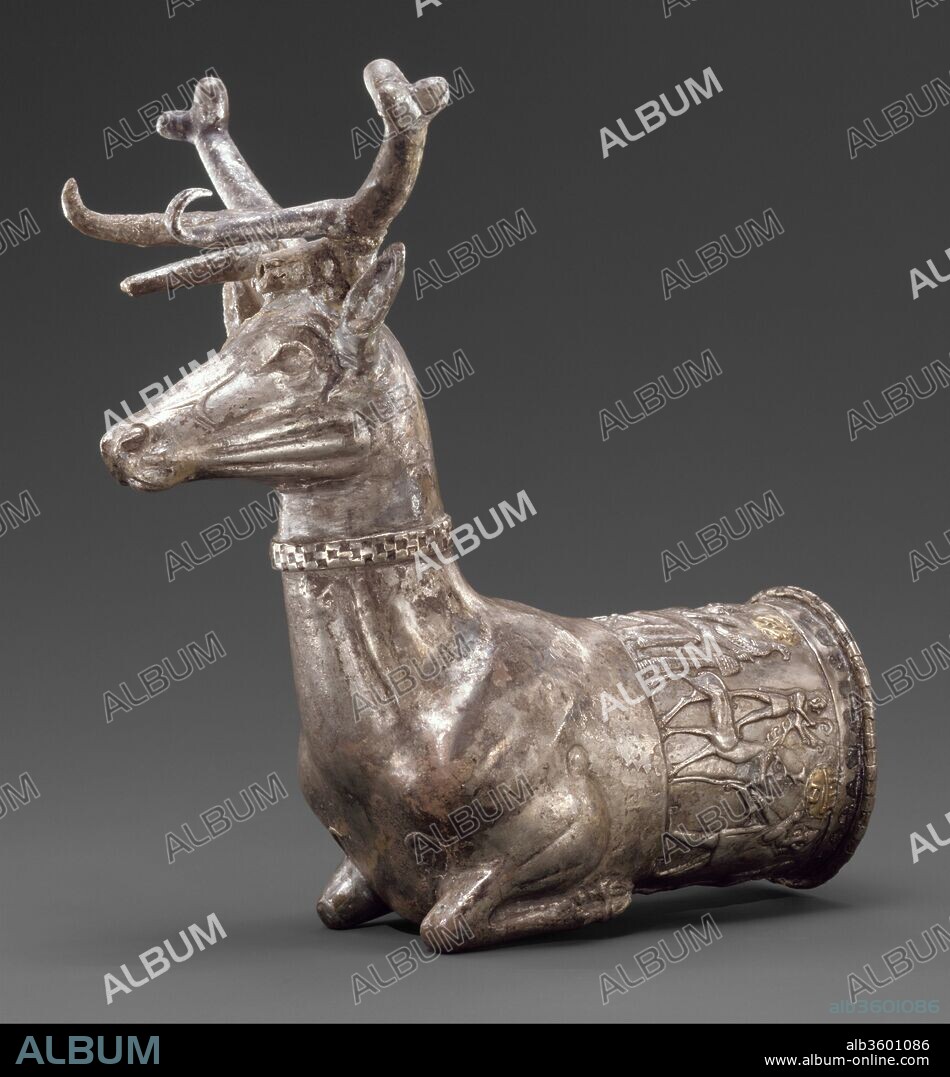alb3601086
Vessel terminating in the forepart of a stag

|
Zu einem anderen Lightbox hinzufügen |
|
Zu einem anderen Lightbox hinzufügen |



Haben Sie bereits ein Konto? Anmelden
Sie haben kein Konto? Registrieren
Dieses Bild kaufen

Titel:
Vessel terminating in the forepart of a stag
Untertitel:
Automatische Übersetzung: Gefäß endet im Vorderteil eines Hirsches. Kultur: hethitisch. Maße: H. 18 cm. Datum: ca. 14.-13. Jahrhundert v. Um 1700 v. Chr. hatten Menschen, die Hethitisch ? eine indogermanische Sprache ? sprachen, eine Hauptstadt in Bogazköy (das alte Hattuscha) gegründet und unter einer Reihe mächtiger Könige einen Staat in Zentralanatolien gegründet. Die hethitische Armee griff 1595 v. Chr. Babylon an und zerstörte es teilweise, und 1285 v. Chr. kämpfte sie bei Qadesh in Syrien gegen den ägyptischen König Ramses II. Dieses silberne Rhyton - ein Trinkgefäß in Form eines Tieres mit einem Ausgussloch in der Brust - in Form eines Hirsches wurde aus einem Stück gehämmert, das durch einen schachbrettartigen Ring mit dem Kopf verbunden war. Sowohl die Hörner als auch der Griff wurden separat angebracht. Ein Fries, der eine religiöse Zeremonie darstellt, ziert den Rand des Bechers und weist auf die Verwendung hin, für die der Becher bestimmt war. Eine prominente Figur, die für eine Göttin gehalten wird, sitzt auf einem Hocker mit gekreuzten Beinen und hält einen Raubvogel in ihrer linken Hand und eine kleine Tasse in ihrer rechten. Sie trägt eine konische Krone und hat große Ohren, typisch für die hethitische Kunst. Ein pilzförmiger Weihrauchbrenner trennt sie von einem männlichen Gott, der auf dem Rücken eines Hirsches steht. Auch er hält einen Falken in der linken Hand, während er mit der rechten einen kleinen gebogenen Stab umfasst. Drei Männer sind im Profil dargestellt, die sich nach links bewegen und den Gottheiten zugewandt sind. Jeder hält eine Opfergabe an die Gottheiten. Hinter den Männern steht ein Baum oder eine Pflanze, an der die zusammengebrochene Gestalt eines Hirsches ruht. Am Baum hängen ein Köcher mit Pfeilen und ein Gegenstand, der wie eine Tasche aussieht. Zwei vertikale Speere vervollständigen den Fries und trennen den Hirsch von der Göttin. Kultszenen oder religiöse Prozessionen sind in der Kunst des hethitischen Reiches häufig dargestellt, und Texte beziehen sich häufig auf Bäume und Pflanzen, die mit Ritualen oder Festen verbunden sind. Die Texte sagen uns auch, dass Speere verehrte Gegenstände waren, so dass es möglich ist, dass der bei der Jagd getötete Hirsch, wie Köcher und Tasche vermuten lassen, dem Hirschgott geweiht war. Hethitische Texte erwähnen auch, dass den Göttern tierförmige Gefäße aus Gold, Silber, Stein und Holz in der entsprechenden Tierform für ihren eigenen Gebrauch gegeben wurden. Obwohl die genaue Bedeutung des Frieses auf diesem Gefäß noch zu vermuten ist, ist es möglich, dass es das persönliche Eigentum des Hirschgottes sein sollte.
Vessel terminating in the forepart of a stag. Culture: Hittite. Dimensions: H. 18 cm. Date: ca. 14th-13th century B.C..
By 1700 B.C., people speaking Hittite--an Indo-European language--had founded a capital at Bogazköy (ancient Hattusha) and, under a series of powerful kings, established a state in central Anatolia. The Hittite army attacked and partly destroyed Babylon in 1595 B.C., and in 1285 B.C. fought a battle against the Egyptian king Ramesses II at Qadesh in Syria.
This silver rhyton--a drinking vessel in the form of an animal with a pouring hole in its chest--in the form of a stag was hammered from one piece that was joined to the head by a checkerboard-patterned ring. Both the horns and the handle were attached separately. A frieze depicting a religious ceremony decorates the rim of the cup, suggesting the uses for which the cup was intended. A prominent figure, thought to be a goddess, sits on a cross-legged stool, holding a bird of prey in her left hand and a small cup in her right. She wears a conical crown and has large ears, typical of Hittite art. A mushroom-shaped incense burner separates her from a male god who stands on the back of a stag. He, too, holds a falcon in his left hand, while with his right he grasps a small curved staff. Three men are shown in profile, moving to the left and facing the deities. Each holds an offering to the divinities. Behind the men is a tree or plant against which rests the collapsed figure of a stag. Hanging from the tree is a quiver with arrows and an object that appears to be a bag. Two vertical spears complete the frieze and separate the stag from the goddess.
Cult scenes or religious processions are commonly represented in the art of the Hittite Empire, and texts make frequent reference to trees and plants associated with rituals or festivals. The texts also tell us that spears were venerated objects, so it is possible that the stag, killed in hunt, as is suggested by the quiver and bag, was being dedicated to the stag god. Hittite texts also mention that animal-shaped vessels made of gold, silver, stone, and wood, in the appropriate animal form, were given to the gods for their own use. Though the precise meaning of the frieze on this vessel remains a matter of conjecture, it is possible that it was intended to be the personal property of the stag god.
Technik/Material:
Silver, gold inlay
Zeitraum:
Hittite Empire
Museum:
Metropolitan Museum of Art, New York, USA
Bildnachweis:
Album / Metropolitan Museum of Art, NY
Freigaben (Releases):
Model: Nein - Eigentum: Nein
Rechtefragen?
Rechtefragen?
Bildgröße:
3585 x 3865 px | 39.6 MB
Druckgröße:
30.4 x 32.7 cm | 11.9 x 12.9 in (300 dpi)
Schlüsselwörter:
 Pinterest
Pinterest Twitter
Twitter Facebook
Facebook Link kopieren
Link kopieren Email
Email
